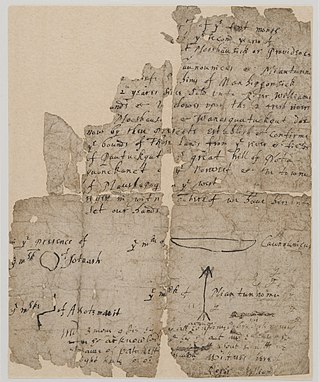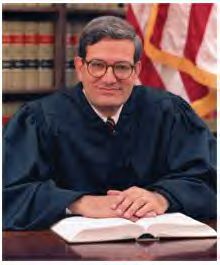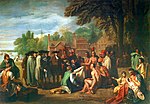
In common-law legal systems, laches is a lack of diligence and activity in making a legal claim, or moving forward with legal enforcement of a right, particularly in regard to equity. This means that it is an unreasonable delay that can be viewed as prejudicing the opposing party. When asserted in litigation, it is an equity defense, that is, a defense to a claim for an equitable remedy.
Trespass is an area of tort law broadly divided into three groups: trespass to the person, trespass to chattels, and trespass to land.

The Oneida people are a Native American tribe and First Nations band. They are one of the five founding nations of the Iroquois Confederacy in the area of upstate New York, particularly near the Great Lakes.
The Nonintercourse Act is the collective name given to six statutes passed by the United States Congress in 1790, 1793, 1796, 1799, 1802, and 1834 to set Amerindian boundaries of reservations. The various acts were also intended to regulate commerce between settlers and the natives. The most notable provisions of the act regulate the inalienability of aboriginal title in the United States, a continuing source of litigation for almost 200 years. The prohibition on purchases of Indian lands without the approval of the federal government has its origins in the Royal Proclamation of 1763 and the Confederation Congress Proclamation of 1783.
Ejectment is a common law term for civil action to recover the possession of or title to land. It replaced the old real actions and the various possessory assizes where boundary disputes often featured. Though still used in some places, the term is now obsolete in many common law jurisdictions, in which possession and title are sued by the actions of eviction and quiet title, respectively.

The Cayuga Nation of New York is a federally recognized tribe of Cayuga people, based in New York, United States. Other organized tribes with Cayuga members are the federally recognized Seneca-Cayuga Tribe of Oklahoma and the Canadian-recognized Six Nations of the Grand River First Nation in Ontario, Canada.

Pro-Football, Inc. v. Harjo, 415 F.3d 44, is a case in which the U.S. Court of Appeals for the District of Columbia considered the decision of the United States Patent and Trademark Office's Trademark Trial and Appeal Board (TTAB) to cancel the registration of the Washington Redskins football team, based on the claim that the name was disparaging to Native Americans. The Court of Appeals did not actually reach the merits of the TTAB's decision; it sent the case back to the trial court for consideration of a procedural issue.

The Oneida Indian Nation (OIN) or Oneida Nation is a federally recognized tribe of Oneida people in the United States. The tribe is headquartered in Verona, New York, where the tribe originated and held territory prior to European colonialism, and continues to hold territory today. They are Iroquoian-speaking people, and one of the Five Nations of the Iroquois Confederacy, or Haudenosaunee. The Oneida are known as "America's first allies" as they were the first, and one of the few, Iroquois nations to support the American cause. Three other federally recognized Oneida tribes operate in locations where they migrated or were removed to during and after the American Revolutionary War: one in Wisconsin in the United States, and two in Ontario, Canada.
Equitable remedies are judicial remedies developed by courts of equity from about the time of Henry VIII to provide more flexible responses to changing social conditions than was possible in precedent-based common law.

An adequate remedy or adequate remedy at law is part of a legal remedy which the court deems satisfactory, without recourse to an equitable remedy This consideration expresses to the court whether money should be awarded or a court order should be decreed.. Adequate remedy at law refers to the sufficient compensation for the loss or damages caused by the defendant with a proper monetary award. The court must grant the adequacy of remedy that will lead to a "meaningful hearing". Whether legal damages or equitable relief are requested depends largely on,whether or not the remedy can be valued. Both two elements, compensation and the meaningfulness of hearing, provide a proper way to have an adequate remedy. The word "meaningfulness" of hearing in the law process is the assumption that the defendant compensated must be meaningful for the injured party where the defendant made a fully covered compensation for all the losses. Hence, the hearing in which cannot give any right amount of compensation award or settlement is not "meaningful", and the unavailability of the compensation will lead to an inadequate remedy. The adequate remedy at law is the legal remedies by meaning it is satisfactory compensation by way of monetary damages without granting equitable remedies.
City of Sherrill v. Oneida Indian Nation of New York, 544 U.S. 197 (2005), was a Supreme Court of the United States case in which the Court held that repurchase of traditional tribal lands 200 years later did not restore tribal sovereignty to that land. Justice Ruth Bader Ginsburg wrote the majority opinion.

The United States was the first jurisdiction to acknowledge the common law doctrine of aboriginal title. Native American tribes and nations establish aboriginal title by actual, continuous, and exclusive use and occupancy for a "long time." Individuals may also establish aboriginal title, if their ancestors held title as individuals. Unlike other jurisdictions, the content of aboriginal title is not limited to historical or traditional land uses. Aboriginal title may not be alienated, except to the federal government or with the approval of Congress. Aboriginal title is distinct from the lands Native Americans own in fee simple and occupy under federal trust.
Oneida Indian Nation of New York v. County of Oneida, 414 U.S. 661 (1974), is a landmark decision by the United States Supreme Court concerning aboriginal title in the United States. The original suit in this matter was the first modern-day Native American land claim litigated in the federal court system rather than before the Indian Claims Commission. It was also the first to go to final judgement.
County of Oneida v. Oneida Indian Nation of New York State, 470 U.S. 226 (1985), was a landmark United States Supreme Court case concerning aboriginal title in the United States. The case, sometimes referred to as Oneida II, was "the first Indian land claim case won on the basis of the Nonintercourse Act."
Seneca Nation of Indians v. Christy, 162 U.S. 283 (1896), was the first litigation of aboriginal title in the United States by a tribal plaintiff in the Supreme Court of the United States since Cherokee Nation v. Georgia (1831). It was the first such litigation by an indigenous plaintiff since Fellows v. Blacksmith (1857) and its companion case of New York ex rel. Cutler v. Dibble (1858). The New York courts held that the 1788 Phelps and Gorham Purchase did not violate the Nonintercourse Act, one of the provisions of which prohibits purchases of Indian lands without the approval of the federal government, and that the Seneca Nation of New York was barred by the state statute of limitations from challenging the transfer of title. The U.S. Supreme Court declined to review the merits of lower court ruling because of the adequate and independent state grounds doctrine.
Confederation Congress Proclamation of 1783 was a proclamation by the Congress of the Confederation dated September 22, 1783 prohibiting the extinguishment of aboriginal title in the United States without the consent of the federal government. The policy underlying the proclamation was inaugurated by the Royal Proclamation of 1763, and continued after the ratification of the United States Constitution by the Nonintercourse Acts of 1790, 1793, 1796, 1799, 1802, and 1833.

The Narragansett land claim was one of the first litigations of aboriginal title in the United States in the wake of the U.S. Supreme Court's landmark Oneida Indian Nation of New York v. County of Oneida (1974), or Oneida I, decision. The Narragansett claimed a few thousand acres of land in and around Charlestown, Rhode Island, challenging a variety of early 19th century land transfers as violations of the Nonintercourse Act, suing both the state and private land owners.

Aboriginal title in New York refers to treaties, purchases, laws and litigation associated with land titles of aboriginal peoples of New York, in particular, to dispossession of those lands by actions of European Americans. The European purchase of lands from indigenous populations dates back to the legendary Dutch purchase of Manhattan in 1626, "the most famous land transaction of all." More than any other state, New York disregarded the Confederation Congress Proclamation of 1783 and the follow-on Nonintercourse Acts, purchasing the majority of the state directly from the Iroquois nations without federal involvement or ratification.
The Indian Claims Limitations Act of 1982 (ICLA) is a United States federal statute of limitations that governs some types of claims by Native American tribes and claims by the federal government on behalf of tribes.
Petrella v. Metro-Goldwyn-Mayer, Inc., 572 U.S. 663 (2014), is a United States Supreme Court copyright decision in which the Court held 6-3 that the equitable defense of laches is not available to copyright defendants in claims for damages.











